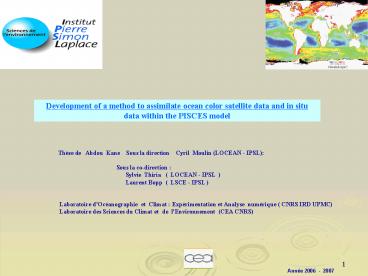Prsentation PowerPoint PowerPoint PPT Presentation
1 / 16
Title: Prsentation PowerPoint
1
Development of a method to assimilate ocean color
satellite data and in situ data within the PISCES
model
Thèse de Abdou Kane Sous la direction
Cyril Moulin (LOCEAN - IPSL)
Sous la co-direction
Sylvie
Thiria ( LOCEAN - IPSL )
Laurent Bopp ( LSCE
- IPSL )
Laboratoire d'Océanographie et Climat
Expérimentation et Analyse numérique ( CNRS IRD
UPMC) Laboratoire des Sciences du Climat et de
l'Environnement (CEA CNRS)
Année 2006 - 2007
2
New ocean color data available
SEAWIFS
PISCES
Annual mean Chl
Annual mean frequency of diatom blooms
Bopp et al., 2005
3
General description of the method
Goal Optimize the physiological parameters of
the two phytoplankton species simulated in PISCES
using an assimilation technique
Physiological Parameters
PISCES (direct model)
-Production -Grazing -Mortality
Satellite In-situ Observations
Adjustment of the parameters using the adjoint
model ( Yao software)
4
ORGANIZATION of a YAO APPLICATION
(semi-generator of adjoint code in c/c)
Intervention of the user
Automatic part
standard code of Yao -
functions - Interpréteur -
generator
Model description
Main file
Generated sources
source Modules
Instruction file
Executable of the application
Results
5
Current version of PISCES 1D in YAO
PISCES has been implemented within YAO. This
requires to rewrite the standard fortran code
using the YAO formalism. The current version is
off-line (forced by ORCA simulations) and 1D
(only the vertical diffusion is accounted for).
BATS Station
6
Parameters to optimize
- Sensitivity tests through twin experiments
7
TWIN experiment
1) A first set of parameters allows to simulate
observations 2) These parameters are
perturbated ---gt Errors in the previous
simulation 3) Minimisation of the errors to
retrieve the initial set of parameters
Xo(initial) Xo(perturbated)
Yobs Ymodel
8
Presentation of some preliminary results
2 Observations Dia-CHL and Nano-CHL (similar
to what measures a satellite) 6 parameters to
retrieve production, mortality, grazing rates
for both species assimilation window 1 day 31
vertical levels Perturbation200
Trajectories of the physiological parameters
during the iterative optimization
9
Sensitivity tests
2 days
7
Temporal window of assimilation 2 Observations
and 6 parameters 31 vertical levels
Perturbation 50
3 days
138
10
Sensitivity tests
Winter
Influence of the initial biogeochemical
conditions 2 Observations 6 parameters 31
vertical levels Perturbation 50 assimilation
window 2 days
Spring (bloom bats)
W S
BATS station
The optimization is very sensitive to initial
conditions
11
Sentivity tests
Frequency of observations with a window of 5
days
observations at 5th day
observations at 5th and 15th
days
The number of observations is important (good for
satellite data)
12
Preliminary conclusions , current developments
and overall objectives
- Preliminary conclusions
- - Performances of the assimilation depends on the
initial oceanographic conditions (all parameters
can be retrieved only in specific situations). - - They also depend on the number and frequency of
observations. - Current and future developments
- - Perform more sensitivity tests to better
characterize the performance of our assimilation
technique (number of parameters that can be
retrieve,). - - Use of actual datasets from satellite or from
JGOFS stations instead of simulated
observations (twin experiments) - - Participate to the development of the 3D
version in collaboration with Aymeric Chazottes.
13
(No Transcript)
14
Echantillonnage de la fonction de coût et
visualisation des trajectoires
Mortalité - Broutage
15
Alternatives
-Modéliser grâce à des plusieurs minimisations le
lieu des minima locaux (régressions linéaires
ou non linéaires) -Explorer via monte carlo ou
un recuit simulé autour des régressions avec
comme paramètre de fluctuations l'écart type de
la régression
16
Annexes
Broutage1
Broutage0.96
Broutage 1.3

